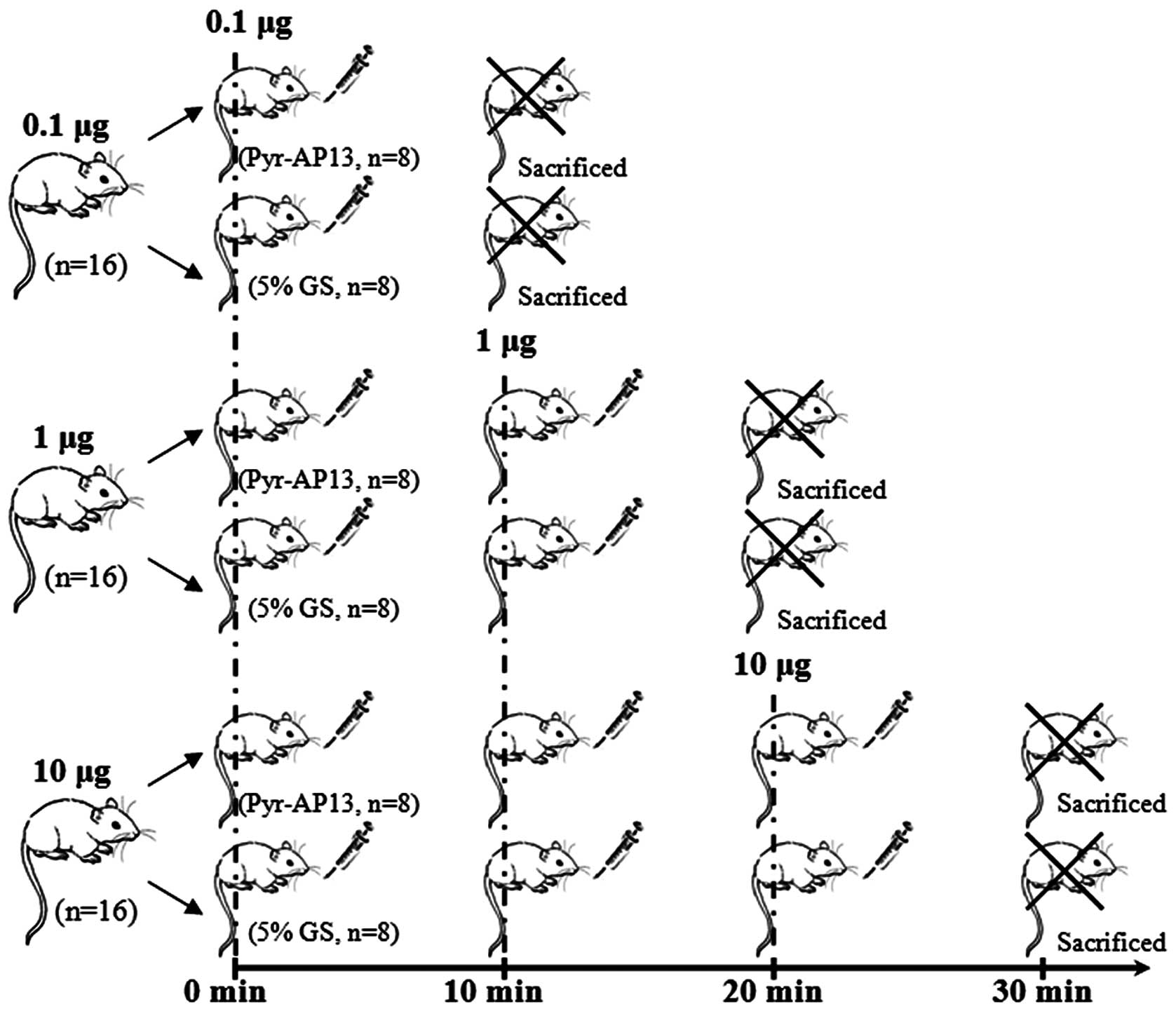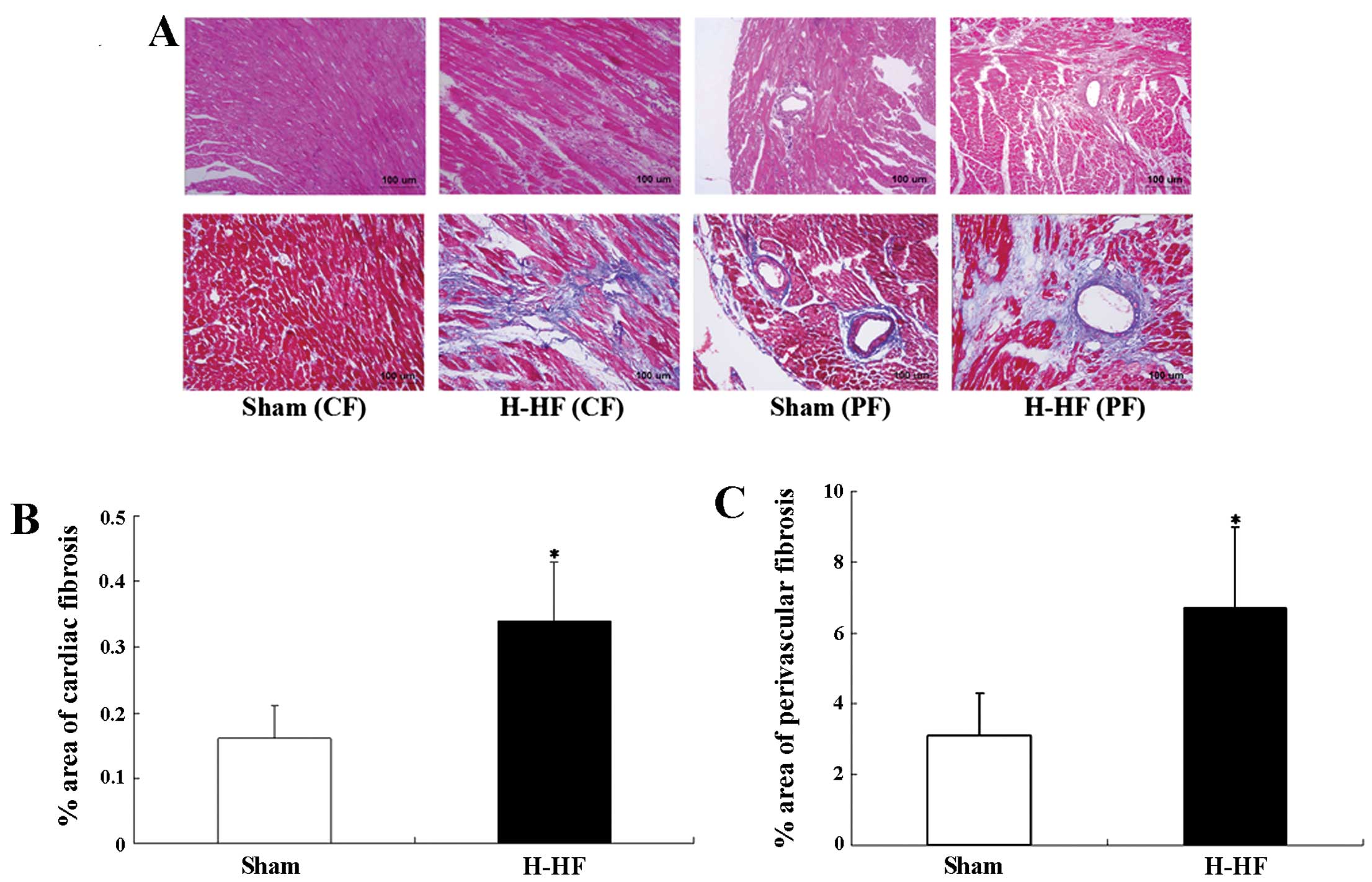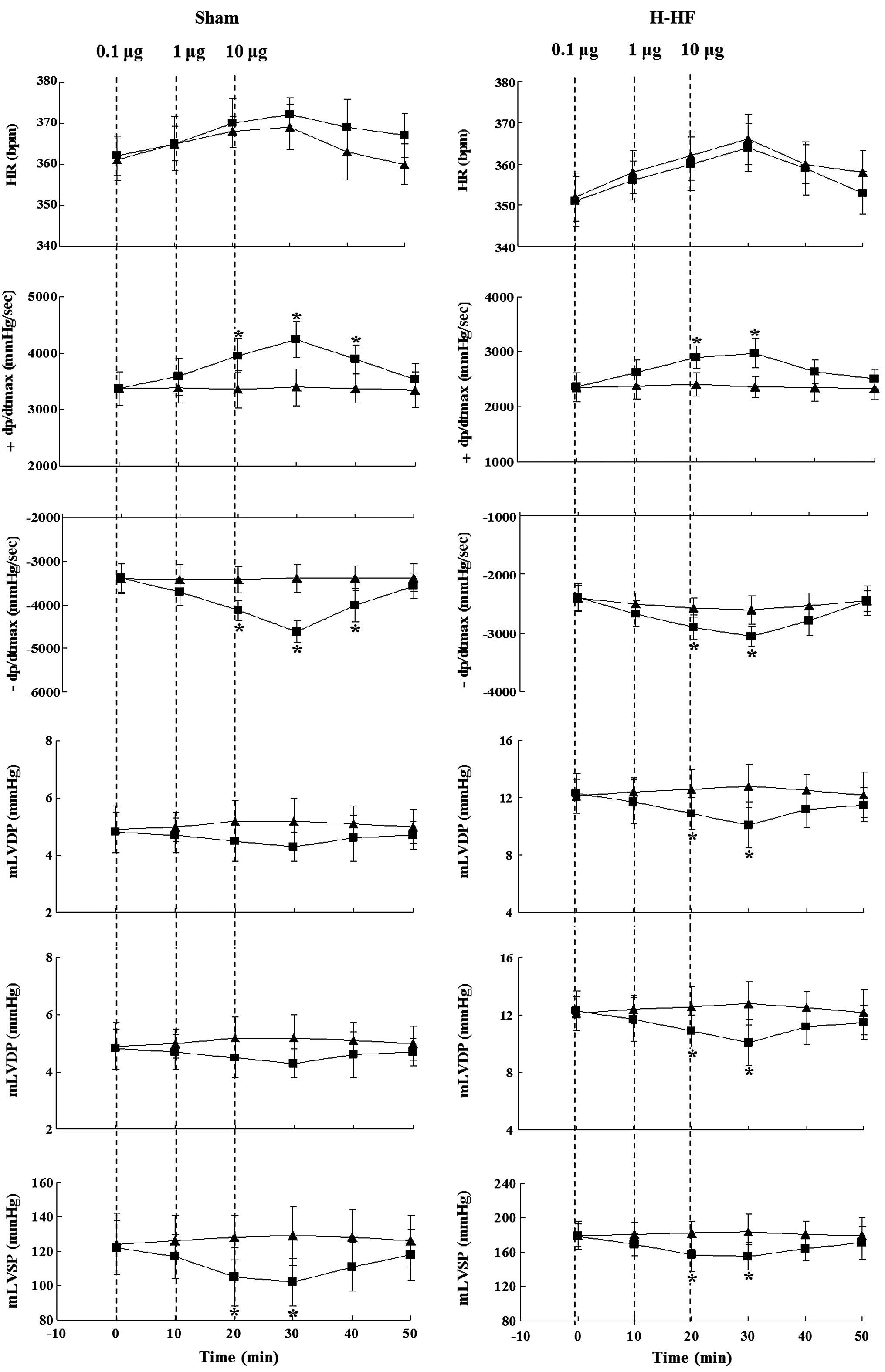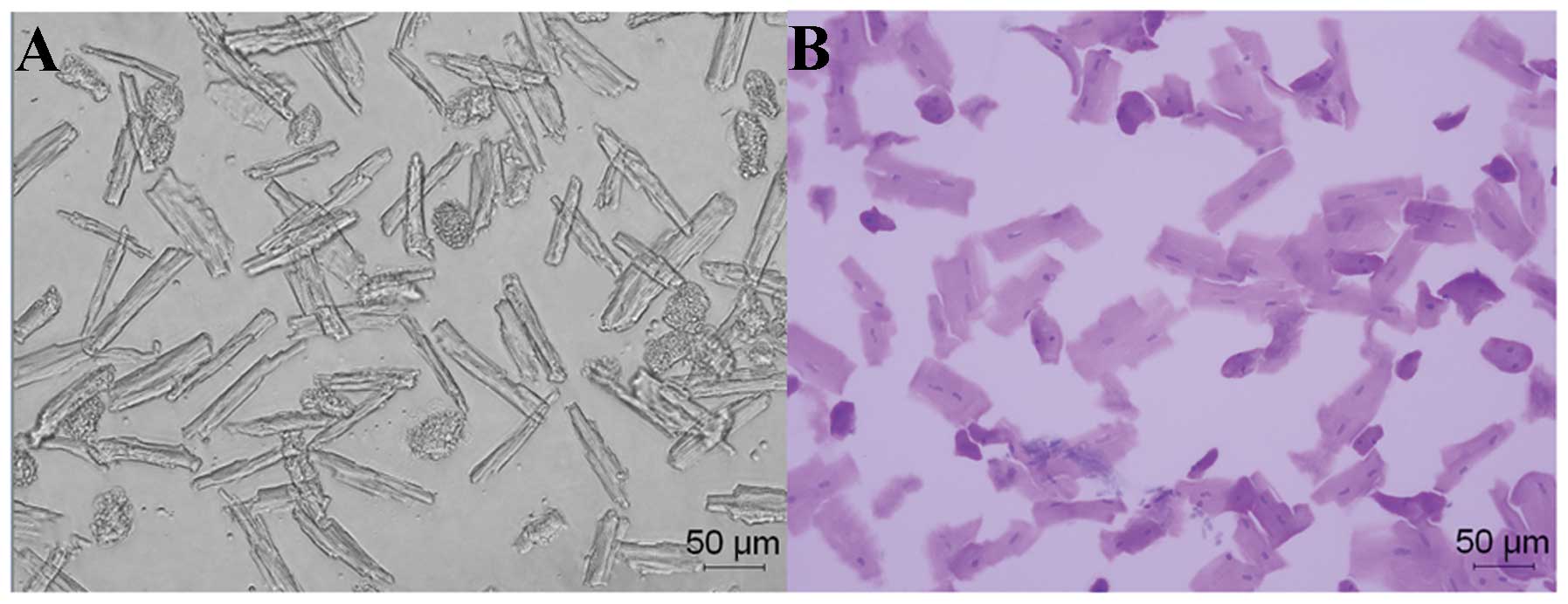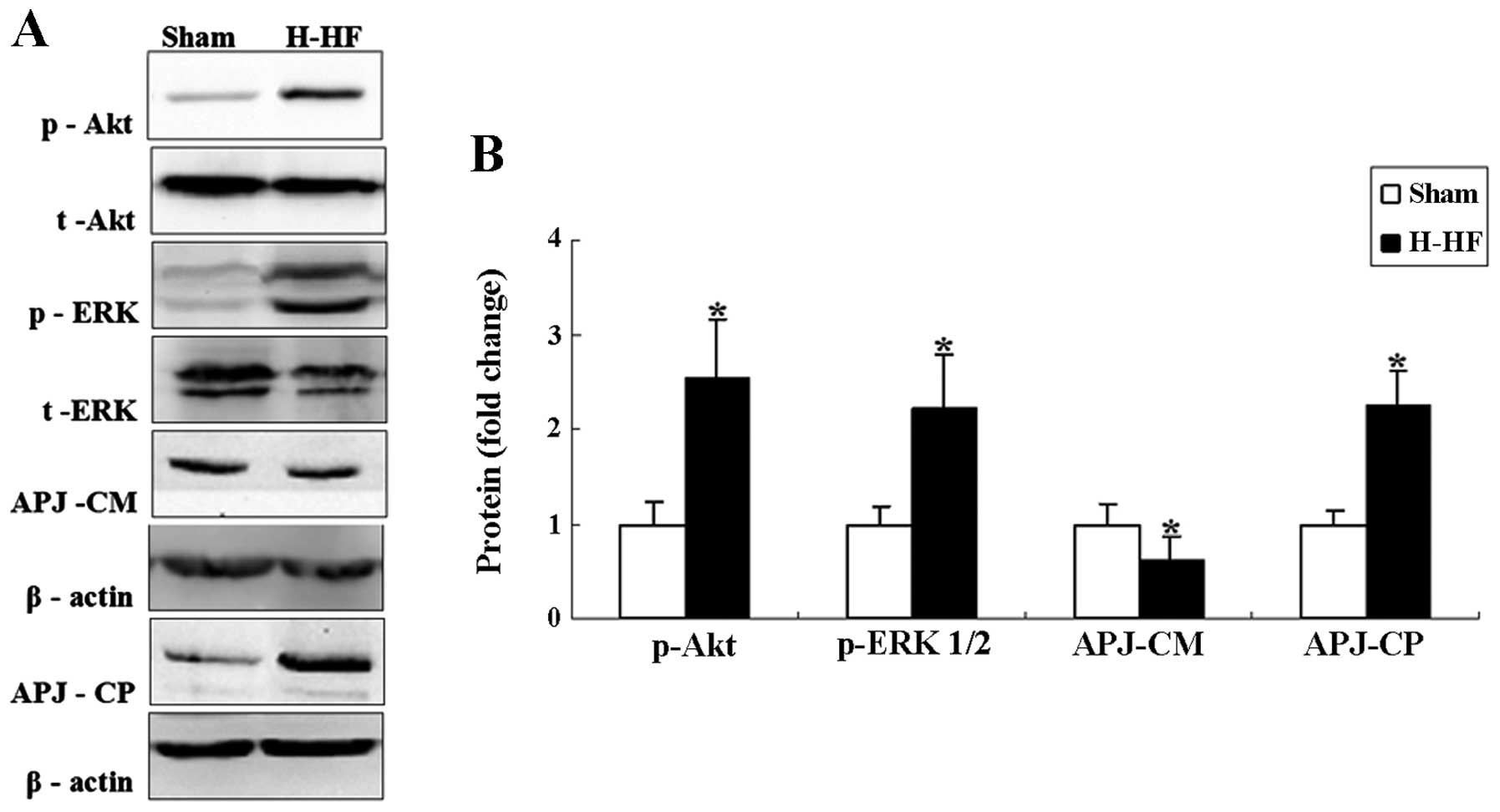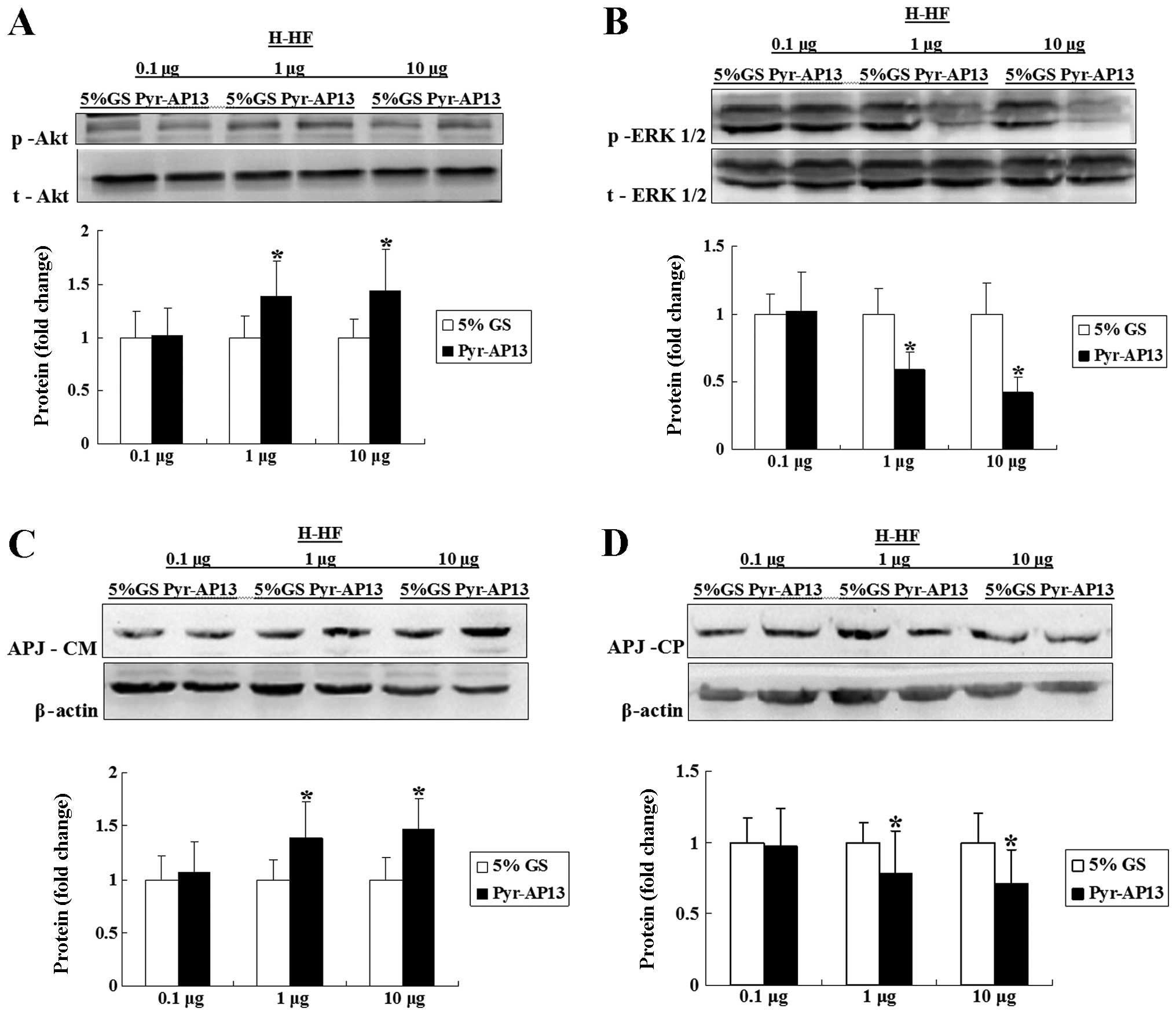Effect of apelin on the cardiac hemodynamics in hypertensive rats with heart failure
- Authors:
- Published online on: July 2, 2014 https://doi.org/10.3892/ijmm.2014.1829
- Pages: 756-764
-
Copyright: © Pang et al. This is an open access article distributed under the terms of Creative Commons Attribution License [CC BY_NC 3.0].
Abstract
Introduction
Apelin peptide, the endogenous ligand of apelin receptor (APJ), was first purified by Tatemoto et al (1) from bovine stomach extracts by means of the reverse pharmacology approach. The N-terminal amino acid sequence of the apelin precursor peptide is a signal peptide, while the C-terminal fragments can bind with high affinity to APJ and exert biological activities. Currently, preproapelin contains several proteolytic cleavage sites by changing the formation of C-terminal peptides, such as apelin-36, apelin-13 and apelin-12. However, pyroglutamylated apelin-13 (Pyr-AP13) has been identified as a potentially important mediator in the vascular and cardiac actions of the human heart (2). According to our knowledge, both apelin and angiotensin II (Ang II) are physiological substrates of human angiotensin-converting enzyme-related carboxypeptidase (ACE2). APJ shows high sequence similarity with the Ang II type-1 receptor, but Ang II is not the endogenous ligand of APJ. Regardless of the multiple common characteristics between the apelin-APJ and Ang II-AT1 systems, the apelin-APJ signaling pathway appears to have a number of opposing physiological and pathophysiological roles to the renin-angiotensin system (3). For instance, Ang II levels increase, whereas apelin levels decrease in heart failure. According to a previous study, enhanced green fluorescent protein was used to tag the C-terminal end of apelin (4) and was stably expressed in Chinese hamster ovarian (CHO) cells. The results of that study indicated that APJ may have different configurational states, based on which to maintain its stability through binding of various apelin fragments to the apelin receptor.
Previous studies, performed on animals and humans, have indicated that apelin exerts definite protective effects on various cardiovascular diseases, including hypertension, cardiac hypertrophy, heart failure and myocardial ischemia-reperfusion injury (5). It can attenuate peripheral vascular resistance and regulate blood pressure by relaxing blood vessels, inhibiting arteriosteogenesis, improving vascular function and adjusting water-salt balance (6–8). Additionally, it can improve heart function by enhancing myocardial contractility, limiting oxidative stress and inhibiting hypertrophy (9) and the apoptosis of cardiomyocytes (10). A recent study which enrolled 232 hypertensive patients and 76 healthy controls reported that lower plasma apelin levels were observed in the hypertensive patients compared with the control group (265±127 vs. 330±159 pg/ml; P<0.001), and the lower plasma apelin levels were independently related to left ventricular systolic and diastolic function impairment (11). In the present study, we focused our attention on the exogenous infusion of Pyr-AP13 in hypertensive rats with heart failure, and the fascinating perspectives provided by the development of a novel specific biological target for the treatment and control of progressive cardiac dysfunction.
Materials and methods
Animals and reagents
The experimental protocol was approved by the Animal Care and Use Committee of Xuzhou Medical College, Xuzhou, China. Six-week-old male Sprague-Dawley (SD) rats were provided by the Animal Department, Xuzhou Medical College. The rats were housed in a climate-controlled room. Sterile water and standard chow diet were available ad libitum. Rabbit polyclonal anti-APJ antibody, anti-total-Akt (t-Akt), anti-phosphorylation-Akt (p-Akt), anti-total-extracellular signal-regulated kinase 1/2 (t-ERK1/2) antibody and anti-phosphorylated-ERK1/2 (p-ERK1/2) antibody were purchased from Santa Cruz Biotechnology (Santa Cruz, CA, USA). All other reagent-grade chemicals were purchased from the Sigma-Aldrich Chemical Co. (St. Louis, MO, USA).
Creation of hypertensive rats
Male SD rats (200–220 g) were subjected to hypertension as previously described (12). Briefly, under 10% chloral hydrate (300 mg/kg, intraperitoneally) anesthesia, the left renal artery was dissected from the surrounding tissues. Subsequently, a U-shaped silver clip with an internal diameter of 0.2 mm was placed around the left renal artery to constrict partially. Sham-operated rats underwent a similar procedure without the clipping of the left renal artery. The left flank incision was closed using catgut and silk suture materials and the systolic blood pressure (SBP) of the animals was measured weekly with a tail-cuff. Four weeks after clipping, the animals were considered hypertensive if the SBP was higher than 160 mmHg (BP-2000 system; Visitech Systems, Apex, NC, USA), as previously described (13).
Echocardiography
The animals were assessed via a 10S phased array probe (11.5 MHz) and a Vivid 7 Dimension system (GE Healthcare Ultrasound, Horten, Norway). Seventeen weeks after the surgery, all the rats were anesthetized with 10% chloral hydrate for the non-invasive examination. The parameters measured were the following: the left ventricular internal dimension at end diastole (LVIDd), interventricular septal thickness at end diastole (IVSd), left ventricular posterior wall thickness at end diastole (LVPWd), left ventricular fractional shortening (FS%) and ejection fraction (EF%). All parameters were measured 5 times by the same observer in a blinded manner, with the final result being the average of the 5.
Histological determination of fibrosis
Fresh heart ventricles from the sham-operated rats (n=8) and the H-HF rats (n=8) were fixed using 4% paraformaldehyde, dehydrated with alcohol, embedded in paraffin and cut into 5-mm-thick slices using a rotary microtome (RM2016; Leica Microsystems, Wetzlar, Germany). The slices were then stained with hematoxylin and eosin or Masson’s trichrome, and observed at x200 magnification using an inverted microscope (IX71; Olympus, Tokyo, Japan).The area of cardiac and perivascular fibrosis was scored in a blinded manner in 6 randomly selected areas per sample and analyzed using Adobe ImageReady 7.0.1 software (Adobe Systems, San Jose, CA, USA).
Apelin bolus and hemodynamic responses
The left jugular vein of one set of animals (16 sham-operated rats and 16 H-HF rats), was treated with a continuous intravenous infusion of either 5% glucose injection (GS) alone or 5% GS containing Pyr-AP13 (Bachem, Bubendorf, Switzerland) in incremental doses as intravenous bolus injections of 0.1, 1 and 10 μg at 10-min intervals using a polyethylene catheter. The control solution was administered in a dose, time-matched design. One end of the second polyethylene catheter was introduced into the left ventricle (LV) retrograde through the right jugular artery. The other end was affixed to the RM 6240 multi-channel physiological signal system (Chengdu Instruments, Chengdu, China) via a pressure transducer. After the above intervention, the study did not begin until the hemodynamics had returned to a steady state. The record of hemodynamic responses was continued for 60 min in each group, commencing 10 min prior to the bolus administration as the baseline hemodynamic measurement and an additional 30 min beyond the final bolus. Measurements were digitally integrated in 10-min recording periods, from which an average value was calculated and the data were recorded at preset intervals throughout the study.
The parameters measured were the following: the heart rate (HR), mean left ventricular systolic pressure (mLVSP), mean left ventricular diastolic pressure (mLVDP) and maximum rate of LV pressure (± dP/dtmax). All measurements were made with the animals under full anesthesia and the body temperature maintained at 36–37°C using a ST-1 homeothermic blanket system (Chengdu Instruments).
Cardiomyocyte isolation
The animals were divided into 5 groups: i) the sham-operated group (n=8); ii) H-HF (n=8); iii) 0.1 μg: H-HF with infusion of 0.1 μg dose of Pyr-AP13 (n=8) or 5% GS (n=8) at 0 min and sacrificed at 10 min; iv) 1 μg: H-HF with infusion of 1 μg dose of Pyr-AP13 (n=8) or 5% GS (n=8) in incremental doses of 0.1 μg and 1 μg at 10-min intervals, and sacrificed at 20 min; and v) 10 μg: H-HF with infusion of 10 μg dose of Pyr-AP13 (n=8) or 5% GS (n=8) in incremental doses of 0.1 μg, 1 μg and 10 μg at 10-min intervals, and sacrificed at 30 min (Fig. 1).
A Langendorff isolated perfused heart assay was performed as previously described (14). The heart was rapidly cannulated via the aorta attached to a Langendorff perfusion apparatus and perfused with KH solution [119 mM NaCl, 4.7 mM KCl, 1.2 mM KH2PO4, 0.94 mM MgSO4·7H2O, 25 mM NaHCO3 and 11.5 mM glucose·H2O (pH=7.4)] containing 1 mM Ca2+ at 37°C for 5 min in a retrograde manner. Subsequently, this solution was changed to a low-Ca2+ solution (120 mM NaCl, 5.4 mM KCl, 5 mM MgSO4·7H2O, 5 mM sodium pyruvate, 20 mM glucose·H2O, 20 mM taurine, 10 mM HEPES, 5 mM NTA and 12 mM Ca2+) followed by perfusion for 5 min. Finally, the perfusate buffer was substituted with 1 mg/ml collagenase buffer (low-Ca2+ solution containing 50 μmol/l Ca2+, but without NTA) for 10 min. The temperature remained at 37°C throughout the perfusion. The heart ventricles were cut into small sections and incubated with collagenase buffer in a thermostat water bath tank for 3 min at 35°C. The cardiomyocytes were collected by centrifuging with 400 rpm at room temperature for 1 min using a centrifuge (Avanti J-E; Beckman Coulter, Fullerton, CA, USA).
Determination of cyclic adenosine 3′,5′-monophosphate (cAMP) concentration
The cardiomyocytes were washed 3 times in cold PBS. The concentration was regulated to 1x106 cells/ml using cell lysis buffer. After 3 cycles of freezing (-20°C)/thawing, the supernatant was obtained through centrifuging at 600 x g for 10 min at 4°C using a microfuge (Microfuge 22R; Beckman Coulter) and the cAMP concentration was measured using a Sunrise ELISA reader (Tecan Group Ltd., Männedorf, Switzerland). Based on the manufacturer’s instructions provided with the ELISA kit, the absorbance was read at 450 nm. The intensity of the color was inversely proportional to the concentration of cAMP in the sample.
Western blot analysis
The membrane and cytosolic proteins were extracted from the isolated cardiomyocytes. The protein concentration was determined using bovine serum albumin (BSA) as the standard using a UV-2450 spectrophotometer (Shimadzu, Kyoto, Japan). Proteins subjected to heat denaturation were separated by 10% SDS-PAGE and transferred onto nitrocellulose membranes. Subsequently, the membranes were blocked and incubated with a primary antibody, followed by incubation with the alkaline phosphatase-conjugated secondary antibody with BCIP/NBT chromogenic substrate. All images were captured and analyzed using the Gene Genius system (Syngene, Cambridge, UK).
Statistical analysis
All data are presented as means ± standard deviation. SPSS 13.0 software was used for the data analysis. The Student’s t-test was applied for the statistical significance between the sham-operated group and the H-HF rats. A repeated measure ANOVA with a two-way model was used to calculate the time and treatment differences between the Pyr-AP13-treated groups and the control (untreated) group. A value of P<0.05 was considered to indicate a statistically signficant difference. Where significant differences were identified by ANOVA, priori Fisher’s protected least square difference (LSD) tests were used to calculate the time points which differed significantly from the time-matched control after the start of the intravenous infusion.
Results
Echocardiography images
Seventeen weeks after surgery, a marked increase was observed in the IVSd, LVIDd and LVPWd in the H-HF rats compared with the sham-operated group (P<0.05). Nevertheless, a significant decrease was noted in the FS% and EF% in the H-HF rats compared with the sham-operated group (P<0.05; Table I).
Histological determination of cardiac and perivascular fibrosis
Significant cardiac and perivascular fibrosis was observed in the H-HF rats compared with the sham-operated group (P<0.05; Fig. 2). During the chronic form of heart failure, hemodynamic overload led to cardiomyocyte hypertrophy and apoptosis, extracellular matrix alterations, as well as mesenchymal fibrotic and inflammatory processes. These events were the basis of ‘myocardial remodeling’. Elastin degradation and collagen deposition were mainly involved in medial and intimal calcifications during remodeling of the arterial wall in hypertension. The medial layer was thickened due to the proliferation, differentiation and hypertrophy of the vascular smooth muscle cells. All these pathological modifications were linked to ventricular contractile deficiency and caused severe damage to heart function.
Assessment of Pyr-AP13 on cardiac hemodynamics
Lower doses of Pyr-AP13 (0.1 μg) had no significant effect on the hemodynamic parameters (P>0.05). The HR of the rats in both the sham-operated group and the H-HF rats did not differ significantly with the Pyr-AP13 infusion (P>0.05). A significant decrease was observed in the mLVSP in the sham-operated group and the H-HF rats following the infusion of Pyr-AP13 (1 and 10 μg) (P<0.05). For the highest increase/decrease in the ± dP/dtmax, a significant increase was observed after the infusion of Pyr-AP13 (1 and 10 μg) (P<0.05). Pyr-AP13 (1 and 10 μg) also improved the mLVDP (P<0.05) in the H-HF rats following treatment, although it had no effect on the sham-operated group (P>0.05). After an additional 30 min after the final infusion, the above-mentioned changes gradually returned to the state before intervention (Fig. 3 and Table II).
Table IIHemodynamic changes after 10 min of Pyr-AP13 infusion (10 μg) in the sham-operated rats and H-HF rats. |
cAMP level in isolated left ventricular myocytes
In the present study, decreased cAMP levels were documented in the isolated left ventricular myocytes (Fig. 4) of the H-HF rats (P<0.05; Fig. 5A). Compared with the 5% GS group, no statistically significant difference was noted in the level of cAMP after the infusion of 0.1 μg Pyr-AP13 (P>0.05). Nevertheless, an upregulation in the cAMP level was observed in the H-HF rats following treatment with 1 and 10 μg Pyr-AP13 (P<0.05) compared with 5% GS control (P<0.05; Fig. 5B).
Expression of APJ protein in isolated left ventricular myocytes
The expression of APJ receptor in the cellular membrane (APJ-CM) in the H-HF rats was significantly lower than that of the sham-operated group (P<0.05; Fig. 6). After the infusion of 0.1 μg Pyr-AP13 in the H-HF rats, no significant effect was noted in the expression of APJ-CM (P>0.05). When the dose of Pyr-AP13 was increased to 1 and 10 μg, APJ-CM expression was significantly higher compared with the 5% GS control (P<0.05). As regards the the expression of APJ receptor in the cytoplasm (APJ-CP), its expression in the H-HF rats was higher compared with the sham-operated group (P<0.05). Compared with the 5% GS group, APJ-CP expression in the H-HF rats showed significant a decrease after the infusion of 1 and 10 μg Pyr-AP13 (P<0.05; Fig. 7).
Expression of p-Akt and p-ERK1/2 protein in isolated left ventricular myocytes
Compared with the sham-operated group, a significant increase was observed in the expression of p-Akt and p-ERK1/2 in the H-HF rats (P<0.05; Fig. 6). Compared with the 5% GS control, our results indicated that the expression of p-ERK1/2 was decreased, but the activity of p-Akt was stimulated after the infusion of 1 and 10 μg Pyr-AP13 (P<0.05). The bolus of 0.1 μg Pyr-AP13 had no effect on the expression of p-Akt and p-ERK1/2 (P>0.05; Fig. 7).
Discussion
It is now well established that hypertension is a progressive cardiovascular syndrome arising from complex and interrelated etiologies. The progression of hypertension is associated with functional and structural cardiac and vascular abnormalities, which result significant damage to target organs and even death (15). Patients will eventually develop myocardial fibrosis-based cardiac dilatation and heart failure in the presence of consistent hypertension, which are the most severe complications of hypertension (16). In the present study, rat models of hypertension were induced using the two-kidney and one clip method. Based on that, heart function and the ventricular structure were determined using echocardiography after 17 weeks. The results revealed that IVSd, LVIDd and LVPWd in the H-HF rats were higher compared with the sham-operated group. The FS% and EF% in the group with heart failure were lower compared with the sham-operated group. These results indicated that increased myocardial stiffness and reduced compliance of the myocardium were induced with the elevation of blood pressure and the development myocardial compensatory hypertrophy, which may gradually lead to systolic and diastolic dysfunction.
The apelin-APJ signaling pathway emerges as an important mediator of cardiovascular control. In a previous study, after the placement of a left ventricular assist device (LVAD) in 11 patients with left ventricular dysfunction, the tissue protein levels of apelin and the expression levels of the APJ receptor were increased (17). A recent study (18) indicated that decreased left ventricular end-diastolic diameter (LVEDD) and FS% in rats with heart failure were significantly ameliorated by Pyr-AP13. Pyr-AP13 effectively inhibited the vascular lesion formation and suppressed the expression of inflammation factors, such as tumor necrosis factor-α (TNF-α) and interleukin-1β protein (IL-1β). Another study (19) reported that acute Pyr-AP13 administration increased vasodilatation and the cardiac index and lowered mean arterial pressure and peripheral vascular resistance in patients with heart failure and healthy control subjects. Apelin treatment with an apelin receptor agonist has also been shown to exert protective effects against ischaemia reperfusion injury in rodents (20). These findings suggest that apelin infusion may be of great benefit to these hemodynamic effects of vasodilatation, increased cardiac output, reduced preload and potential inotropy.
In the present study, no hemodynamic changes were observed in the sham-operated group and the H-HF rats after the exogenous infusion of 0.1 μg Pyr-AP13 for 10 min. Nevertheless, mLVSP in both groups (sham-operated group and H-HF rats) and mLVDP in the H-HF rats decreased significantly and ± dP/dtmax in both groups increased significantly after the infusion of 1 and 10 μg Pyr-AP13, demonstrating that Pyr-AP13 increased myocardial contractility, improved diastolic function and reduced peripheral resistance.
It seems that in addition to the above-mentioned negative haemodynamic effects on pre and after-load, some pathological modifications induced by the apelin-APJ system may be involved in the deterioration of cardiac functionality. The orphan seven transmembrane receptor APJ composed of 380 amino acids, is a G-protein-coupled receptor (GPCR) (21). Our data indicated that APJ expression in the cellular membrane showed a marked decrease in the H-HF rats compared with the sham-operated group rats. After the exogenous infusion of 1 and 10 μg Pyr-AP13, a significant increase in APJ expression in the cellular membrane was observed, while APJ expression in the cytoplasm was significantly lower compared with the 5% GS control level. As mentioned above, we suggested that APJ expression was downregulated in the rats with heart failure through removal from the cell surface. Thus, agonist-activated receptors are delivered back to the plasma membrane or facilitate receptors transferred into lysosomes for degradation (22). Endocytosis of APJ receptor played a key role in receptor downregulation. However, a more accurate understanding of the molecular mechanisms underlying the disproportion yet to be obtained.
The critical intracellular second messenger, cAMP, regulates numerous growth and developmental processes in the myocardial cell, including discrete compartments to maintain homeostasis and simultaneously control diverse cellular functions (23). Compared with sham-operated group, the cAMP level in the H-HF rats was decreased. Notably, a significantly higher level of cAMP was observed in the H-HF rats treated with Pyr-AP13 (1 and 10 μg). However, the increased expression of p-ERK1/2 in the H-HF rats was reduced after the infusion of Pyr-AP13 (1 and 10 μg). Based on these results, we speculated that Pyr-AP13 plays a crucial role in the regulation of cellular responses as follows: a complex forms after Pyr-AP13 combined with cellular membrane APJ receptor, which may activate the phosphorylation of ERK1/2 regulated by cAMP.
Crosstalk between the phosphoinositide 3-kinase (PI3K)/ Akt and MEK/ERK cascades is a central regulator of cell metabolism, proliferation and survival (24). Akt and ERK1/2 are pro-survival protein kinases, which confer powerful cardioprotection upon being activated, specifically at the time of myocardial reperfusion as a viable target for cardioprotection in patients with acute myocardial infarction (AMI) (25). In the present study, Akt and ERK1/2 were activated in the H-HF rats. After the infusion of Pyr-AP13 in the H-HF rats, we observed that Akt activation coordinated with ERK inactivation. Therefore, we suggest that the regulation of the crosstalk between the Akt and ERK1/2 cascades may have a protective effect on hypertension with heart failure.
Finally, several mechanisms have been found to play key roles in the limitation of the potential benefit from the exogenous administration of apelin in left ventricular failure. We have summarized these as follows: i) both elastin fragment generation and the deposition of collagen fibers have been linked to remodeling of the arterial wall in hypertension. These changes contribute to the reduction of the elasticity of the vessel associated with extracellular matrix composition and vascular cell phenotype variation (26). ii) The chronic form of heart failure and progressive cardiac dysfunction is constituted by myocardial remodeling. This is a complex pathological process of cardiomyocyte hypertrophy and apoptosis, extracellular matrix alterations, mesenchymal fibrotic and inflammatory processes in response to chronic haemodynamic overload (27). Hence, these effects give rise to a vicious circle between the deterioration of cardiac functionality and myocardial remodeling. iii) Numerous experimental studies have shown that the membrane receptor plays a vital role in translating extracellular signals into intracellular messages and extensively regulates a variety of physiological and pathophysiological processes (28). As previously demonstrated, in H-HF rats, APJ receptor activated by the exogenous infusion of Pyr-AP13, was partially recycled from the cytoplasm back to the plasma membrane. However, downregulation of APJ receptors dominated by lysosomal degradation resulted in a lower combination between Pyr-AP13 and membrane APJ, which limited the effect of Pyr-AP13. APJ in response to activation by an agonist, can be recycled to the plasma membrane as in a fully active state. Plasma apelin level in rats with heart failure decreased, which was conducive to the lower expression of APJ receptors (29).
In conclusion, the downregulated expression of APJ protein in cardiomyocytes with heart failure, without the compensatory upregulation of apelin, may limit the positive inotropic actions of apelin. Our findings suggest that the hypertensive remodeling of the heart during heart failure is accompanied with the endogenous downregulation of APJ receptor, which results in benefits from the exogenous administration of apelin. However, we hypothesized that restoring the expression levels of the APJ receptor by gene transfection may create a favorable environment for the initiation and propagation of the apelin-APJ signaling pathway. Further studies are required to confirm whether it can improve inotropy and depress peripheral resistance in a fully active state.
Acknowledgements
This study was supported by grants from the Xuzhou Municipal Bureau of Science and Technology (no. XZZD1020) and the Xuzhou Municipal Health Bureau (no. XWJ2011030).
References
|
Tatemoto K, Hosoya M, Habata Y, et al: Isolation and characterization of a novel endogenous peptide ligand for the human APJ receptor. Biochem Biophys Res Commun. 251:471–476. 1998. View Article : Google Scholar : PubMed/NCBI | |
|
Maguire JJ, Kleinz MJ, Pitkin SL, et al: [Pyr1] apelin-13 identified as the predominant apelin isoform in the human heart: vasoactive mechanisms and inotropic action in disease. Hypertension. 54:598–604. 2009. | |
|
Chun HJ, Ali ZA, Kojima Y, et al: Apelin signaling antagonizes Ang II effects in mouse models of atherosclerosis. J Clin Invest. 118:3343–3354. 2008.PubMed/NCBI | |
|
Iturrioz X, El Messari S, De Mota N, et al: Functional dissociation between apelin receptor signaling and endocytosis: implications for the effects of apelin on arterial blood pressure. Arch Mal Coeur Vaiss. 100:704–708. 2007.PubMed/NCBI | |
|
Rastaldo R, Cappello S, Folino A, et al: Effect of apelin-apelin receptor system in postischaemic myocardial protection: a pharmacological postconditioning tool? Antioxid Redox Signal. 14:909–922. 2011. View Article : Google Scholar : PubMed/NCBI | |
|
Iturrioz X, Alvear-Perez R, De Mota N, et al: Identification and pharmacological properties of E339-3D6, the first nonpeptidic apelin receptor agonist. FASEB J. 24:1506–1517. 2010. View Article : Google Scholar : PubMed/NCBI | |
|
Shan PF, Lu Y, Cui RR, et al: Apelin attenuates the osteoblastic differentiation of vascular smooth muscle cells. PLoS One. 6:e179382011. View Article : Google Scholar : PubMed/NCBI | |
|
Roberts EM, Newson MJ, Pope GR, et al: Abnormal fluid homeostasis in apelin receptor knockout mice. J Endocrinol. 202:453–462. 2009. View Article : Google Scholar : PubMed/NCBI | |
|
Zhang Z, Yu B and Tao GZ: Apelin protects against cardiomyocyte apoptosis induced by glucose deprivation. Chin Med J. 122:2360–2365. 2009.PubMed/NCBI | |
|
Foussal C, Lairez O, Calise D, et al: Activation of catalase by apelin prevents oxidative stress-linked cardiac hypertrophy. FEBS Lett. 584:2363–2370. 2010. View Article : Google Scholar : PubMed/NCBI | |
|
Przewlocka-Kosmala M, Kotwica T, Mysiak A, et al: Reduced circulating apelin in essential hypertension and its association with cardiac dysfunction. J Hypertens. 29:971–979. 2011. View Article : Google Scholar : PubMed/NCBI | |
|
Khalili A, Khosravi MB and Nekooeian AA: The effects of aqueous extract of vaccinium arctostaphylos leaves on blood pressure in renal hypertensive rats. Iran Red Crescent Med J. 13:123–127. 2011.PubMed/NCBI | |
|
Zhou ZY, Yang ZH, Wang XH, et al: Increased expression of insulin-like growth factor-binding protein-3 is implicated in erectile dysfunction in two-kidney one-clip hypertensive rats after propranolol treatment. Asian J Androl. 13:851–855. 2011. View Article : Google Scholar : PubMed/NCBI | |
|
Lewis CJ, Gong H, Brown MJ, et al: Overexpression of β1-adrenoceptors in adult rat ventricular myocytes enhances CGP 12177A cardiostimulation: implications for ‘putative’ β4-adrenoceptor pharmacology. Br J Pharmacol. 141:813–824. 2004. | |
|
Glasser SP, Judd S, Basile J, et al: Prehypertension, racial prevalence and its association with risk factors: analysis of the REasons for Geographic and Racial Differences in Stroke (REGARDS) study. Am J Hypertens. 24:194–199. 2011. View Article : Google Scholar : PubMed/NCBI | |
|
Shahbaz AU, Sun Y, Bhattacharya SK, et al: Fibrosis in hypertensive heart disease: molecular pathways and cardioprotective strategies. J Hypertens. 28(Suppl 1): S25–S32. 2010. View Article : Google Scholar : PubMed/NCBI | |
|
Chen MM, Ashley EA, Deng DX, et al: Novel role for the potent endogenous inotrope apelin in human cardiac dysfunction. Circulation. 108:1432–1439. 2003. View Article : Google Scholar : PubMed/NCBI | |
|
Koguchi W, Kobayashi N, Takeshima H, et al: Cardioprotective effect of apelin-13 on cardiac performance and remodeling in end-stage heart failure. Circ J. 76:137–144. 2012. View Article : Google Scholar : PubMed/NCBI | |
|
Japp AG, Cruden NL, Barnes G, et al: Acute cardiovascular effects of apelin in humans: potential role in patients with chronic heart failure. Circulation. 121:1818–1827. 2010. View Article : Google Scholar : PubMed/NCBI | |
|
Simpkin JC, Yellon DM, Davidson SM, et al: Apelin-13 and apelin-36 exhibit direct cardioprotective activity against ischemia-reperfusion injury. Basic Res Cardiol. 102:518–528. 2007. View Article : Google Scholar : PubMed/NCBI | |
|
Langelaan DN, Reddy T, Banks AW, et al: Structural features of the apelin receptor N-terminal tail and first transmembrane segment implicated in ligand binding and receptor trafficking. Biochim Biophys Acta. 1828.1471–1483. 2013.PubMed/NCBI | |
|
Dang VC and Christie MJ: Mechanisms of rapid opioid receptor desensitization, resensitization and tolerance in brain neurons. Br J Pharmacol. 165:1704–1716. 2012. View Article : Google Scholar : PubMed/NCBI | |
|
Yoshizawa T, Sakurai T, Kamiyoshi A, et al: Novel regulation of cardiac metabolism and homeostasis by the adrenomedullin-receptor activity-modifying protein 2 system. Hypertension. 61:341–351. 2013. View Article : Google Scholar : PubMed/NCBI | |
|
Shaul YD and Seger R: The MEK/ERK cascade: from signaling specificity to diverse functions. Biochim Biophys Acta. 1773:1213–1226. 2007. View Article : Google Scholar : PubMed/NCBI | |
|
Hausenloy DJ and Yellon DM: New directions for protecting the heart against ischaemia-reperfusion injury: targeting the Reperfusion Injury Salvage Kinase (RISK)-pathway. Cardiovasc Res. 61:448–460. 2004. View Article : Google Scholar : PubMed/NCBI | |
|
Rattazzi M, Bertacco E, Puato M, et al: Hypertension and vascular calcification: a vicious cycle? J Hypertens. 30:1885–1893. 2012. View Article : Google Scholar : PubMed/NCBI | |
|
Distefano G and Sciacca P: Molecular pathogenesis of myocardial remodeling and new potential therapeutic targets in chronic heart failure. Ital J Pediatr. 38:412012. View Article : Google Scholar : PubMed/NCBI | |
|
Moser E, Kargl J, Whistler JL, et al: G protein-coupled receptor-associated sorting protein 1 regulates the postendocytic sorting of seven-transmembrane-spanning G protein-coupled receptors. Pharmacology. 86:22–29. 2010. View Article : Google Scholar | |
|
Pang H and Zhang P: Detection of the level of apelin during remodeling in hypertensive heart failure rats. Chin J Clinicians. 6:64–67. 2012. |



